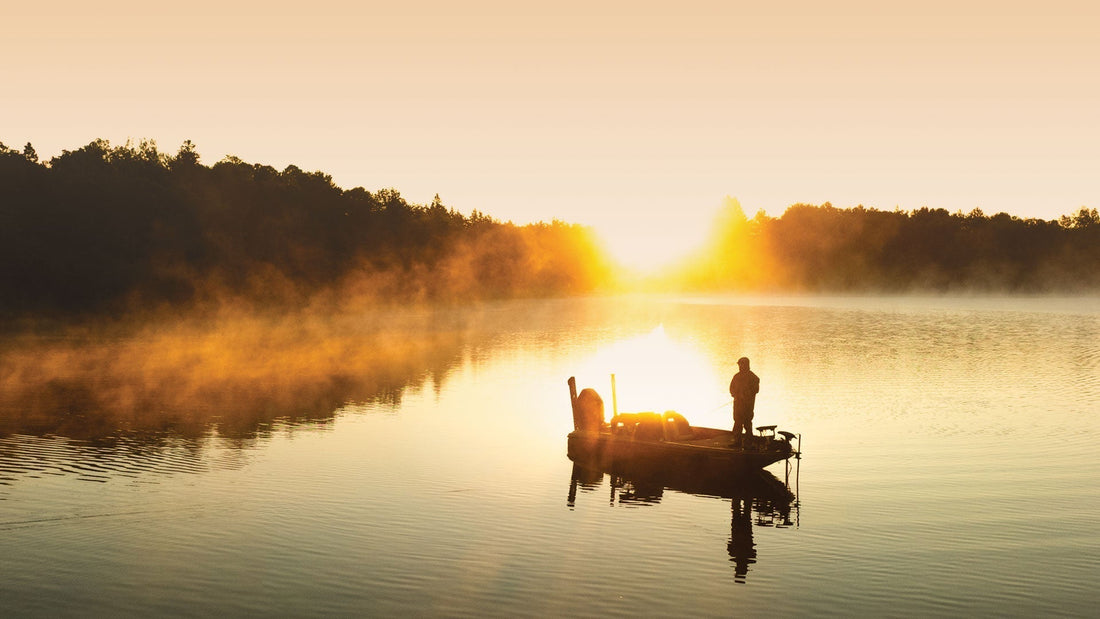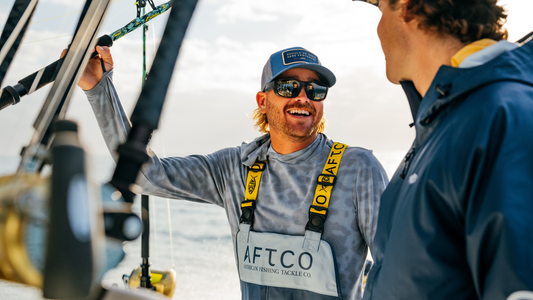
How to Choose the Right Outerwear
Stay ready for anything with outerwear built to handle the elements. The right gear keeps you warm, dry, and comfortable through wind, rain, or snow. Since the weather is always unpredictable, dependable outerwear is essential when you’re out on the water.

What Makes Clothing Warm?
Fabric plays a key role in how well clothing retains warmth. Fleece and polyester are two of the most common outerwear materials, both designed to trap heat. Fleece has a raised surface to lock in body heat and block cold air, while polyester’s tightly woven fibers provide insulation and help repel moisture. While heavier jackets once meant more warmth, modern materials and insulation technologies now deliver lightweight warmth without the bulk.
Soft shells offer warmth without the bulk, shielding anglers from wind and insulating body heat. With a DWR coating, they repel water, keeping you dry and comfortable.

Another key factor in warmth is the fill, especially in down jackets. Down insulation uses soft goose or duck feathers to trap body heat. The higher the fill rating, the more warmth it provides. For example, a jacket with 700+ fill provides excellent insulation for cold conditions, while a 400 fill jacket offers only moderate insulation.
For anglers, outerwear with natural down insulation (feathers) is not a good option because it’s not waterproof. Instead, anglers should opt for outerwear with synthetic insulation. Synthetic insulation is feather-free and has polyester fibers. The polyester dries quickly and keeps anglers warm in wet and cold conditions. An example of a synthetic down jacket is the Crosswind Puff Jacket. It's made from 100% recycled polyester, features a DWR fabric treatment for water repellency, and includes a drawcord hood for an adjustable fit.
Different Types of Outerwear
From hitting the water to tackling everyday activities, AFTCO has outerwear designed to protect you both on and off the water. The AFTCO Coastal Layer is a great example. This lightweight performance fleece, available in a quarter zip and hoodie, is perfect for a casual day at the office, watching a game, or going out to dinner. It also works well as a layering piece with other AFTCO outerwear pieces.
Fleece vs. Softshell
Fleece is popular for its cozy feel and reliable warmth. The Coastal Layer Collection offers lightweight fleece perfect for layering or wearing on its own, on or off the water. For a quarter-zip option, Sentinel pairs easily under vests or jackets. While fleece excels at comfort and insulation, it’s not designed to block wind or rain.
Softshell jackets, like windproof shells, block wind and often feature a DWR coating to repel light rain and snow. They’re also highly breathable, making them ideal for active movement on the water. While fishing isn’t a high-intensity sport, repeated casting and reeling can generate heat, and softshells help regulate temperature. Most are made from durable, breathable polyester that wicks moisture away. Layer a softshell over your fleece for extra warmth on cool, windy, or rainy fall days.
Softshell vs. Windbreaker
Softshell jackets offer anglers versatility as mid or outer layers, depending on the conditions. AFTCO softshells, like the Reaper Windproof Jacket and Reaper Windproof Pullover, provide durability, comfort, and breathability. They feature a DWR finish, laser-cut vented underarms for airflow, and adjustable shock cord hoods. The Hexatron fleece lining locks in warmth for added comfort. These softshells are designed to protect against the elements and are ideal for mild conditions.
As the name implies, windbreakers are designed to block wind and light rain, making them ideal for mild conditions. While they offer minimal insulation, pairing one with a fleece or sweatshirt adds warmth when needed. AFTCO’s Crossing Jacket is an excellent option with built-in wind resistance, DWR water repellence, and waterproof zippers for added protection. It also packs neatly into a stuff sack, perfect for travel or stashing in your boat bag.
Lightweight Shell vs. Heavy Shell
The Crossing Jacket or Hydro Jacket is a smart choice for anglers facing light wind and rain in mild climates. The lightweight Crossing rain suit packs down easily for travel and pairs with matching Crossing Pants for full coverage. Key features include a mesh liner with underarm venting for airflow, a self-locking cinch hood to stay secure at high speeds, and adjustable sleeve cuffs for a customizable fit.
The Hydro Jacket is our most affordable fishing rain jacket. It features a durable two-layer nylon shell with a 30K waterproof membrane, making it effective against drizzles and downpours. Double cuffs help prevent water from seeping up your arms, while the SpeedVent™ Hood stays securely in place at high speeds. The Hydro also includes a kill switch safety D-ring attachment. Check out our cold-weather fishing gear checklist for anglers facing more than mild conditions.
When strong winds and heavy rain are in the forecast, anglers should choose a heavy shell with a 20K+ waterproof rating to stay dry and protected. Anything less can leave you soaked and uncomfortable in just a few hours. The Barricade Jacket delivers reliable foul-weather protection with a three-layer construction, DWR water-repellent finish, and adjustable features including a SpeedVent™ hood, double dry cuff system, and hem cinch. For full coverage, pair it with the matching Barricade Bibs.
For all-day wind and heavy rain, reach for the Fortress Jacket. It features a 30K waterproof, 7K breathable Toray® nylon membrane, a SpeedVent™ hood, and double cuffs to keep water from seeping up your sleeves. With Fortress, you're ready for whatever Mother Nature throws your way. To learn more about waterproofing, check out our Waterproof Rundown, and ensure you're always prepared.
How to Choose: Rain Jackets
With impending rain, anglers need gear that will keep them dry in a light sprinkle or a torrential downpour. We've broken down our rain suits into categories below to cut through the clutter and confusion. Other helpful resources for choosing the right outerwear are our Waterproof Rundown and Rain Suit Comparison.
Light Rain: Crossing & Hydro
Gear up with Crossing or Hydro for light wind and rain. The Crossing Jacket is a windbreaker ideal for light rain. It’s packable and comes with a mesh stuff sack. It’s perfect for quick, spotty showers and moderate temperatures.
For steady light rains, Hydro is your go-to. It’s our most affordable 2-layer rain suit that has 30K waterproofing and is DWR water repellent. Hydro also has a SpeedVent™ hood that stays in place at high speeds on the water and a dry cuff system to prevent water from seeping down your sleeves. Whether you prefer the travel-ready Crossing or the feature-rich Hydro, both will keep you dry when light rain or stray showers hit.
Commercial Fishing & Foul Weather: Seafarer & Deep Set
Built for saltwater, the Seafarer Jacket and Seafarer Bib keep commercial anglers dry and comfortable on deck. Made with PU-coated waterproof fabric, these fishing slickers are designed to repel water and withstand harsh marine conditions. The jacket features a lightweight construction, a two-way adjustable hood, and a cinch cord hem for a secure fit. The bibs include adjustable elastic shoulder straps with a swivel buckle to reduce pressure on the shoulders and back. When foul weather rolls in, this lightweight slicker system delivers reliable protection.
Medium to Heavy Rain: Barricade
Anglers should choose the Barricade Jacket for all-day steady rain. This three-layer jacket features a DWR water-repellent finish, making it an excellent year-round rain suit. It's also breathable enough to keep you cool during summer showers. Barricade also includes a two-way adjustable hood, a double dry cuff system, and an internal hem cinch for easy fit adjustments. These features make it ideal for layering during the winter months.
Heavy Rain: Fortress
Built to handle the rough channel crossings of Southern California, Fortress keeps anglers protected when all-day rain is in the forecast. A step up from the Barricade, it’s constructed with Toray® fabric, 30K waterproofing, and 7K breathability for superior foul-weather performance. Pair the Fortress Jacket with its matching bib for complete protection. The Fortress Bib features handwarmer pockets, a 300D plier pocket, and knee-high YKK® AquaGuard® zippers for easy on and off. Adjustable shoulder straps and an internal waist cinch provide a secure, customizable fit. With gear built for the toughest conditions, you can focus on fishing—not the forecast.
Rain Plus Cold: Hydronaut & Barricade
Anglers need a rain suit that delivers warmth and protection in freezing temperatures and pouring rain. Hydronaut is built for harsh conditions, featuring a two-layer jacket with 30K waterproofing and a DWR water-repellent finish. Paired with the matching bibs, it provides full coverage against the elements. The Hydronaut Bib includes handwarmer pockets, a relief zipper, and knee-high side zippers for easy on and off over boots.
Anglers are always at the mercy of Mother Nature. Explore our rain suit comparison for a complete breakdown to find the best gear for your conditions. From gusting winds to blowing snow, AFTCO has you covered.















